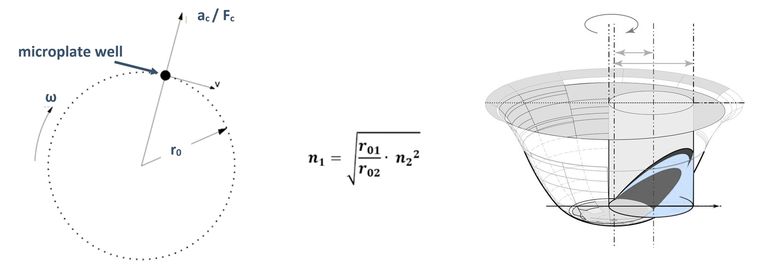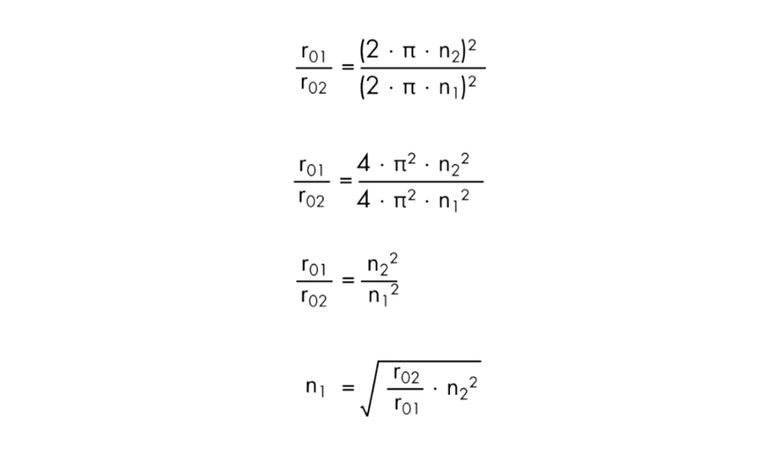Authored by: Andreas Vester

Influence of orbital radius to centrifugal acceleration while microplate mixing
1. Overview
Orbital shaking is undoubtedly a simple and non invasive way for mixing of assay components. The most important requirement for an effective mixing process is the formation of a macroscopic flow. As microplate well volumes decrease the impact of surface tension increases because of the low volume/surface ratio of the usually thin and tall well geometry. For this reason it is necessary to generate a high centrifugal acceleration to achieve an intensive macroscopic flow.
The value of centifugal force respectively acceleration depends on the amplitude r0 and the mixing frequency n. Against expection it is crucial to choose the right value of amplitude r0.
The centrifugal acceleration ac is given by
ac = ω² ∙ r0 , [1/s²]
with the angual velocity ω = 2∙π∙n [1/s], the orbital radius r0 [m] and the mixing frequency n [1/s]
ac = (2 ∙ π ∙ n)² ∙ r0 [1/s²]
The centrifugal force is given by
Fc = m ∙ ac [N]

To achieve an equal centrifugal force or acceleration for the enlargement of the liquid surface in the microplate well against the surface forces (surface tension) with two different instruments (different orbital radius r0) you have to choose different angular velocities ω (mixing frequencies n).
ac = ω1² ∙ r01 = ω2² ∙ r02
ac = (2 ∙ π ∙ n1)² ∙ r01 = (2 ∙ π ∙ n2)² ∙ r02

2. Example calculation to achieve a equal centrifugal acceleration:


Like shown above an equal centrifugal acceleration and centrifugal force for optimized mixing will be reached using an:
BioShake 3000-T elm (article # 2016 – 0517) with an orbital radius of r02= 1.0 mm and n2= 1800 rpm
or
BioShake D30-T elm (article # 2016 – 0518) with an orbital radius of r01= 1.5 mm and n1= 1469 rpm
CONCLUSION: In order to achieve comparable mixing results, a lower mixing frequency must be selected for a larger orbit diameter.
Literature Cited
[1] SIGLOCH, H.: Technische Fluidmechanik. 1. Auflage. Springer Verlag, 2008
[2] BÜCHS, J. ET AL.: Calculating liquid distribution in shake flasks on rotary shakers at waterlike viscosities. In: Biochemical Engineering Journal 34 (2007), S. 200-208
[3] BÜCHS, J. ET AL.: Out-of-phase operating conditions, a hithero unknown phenomen in shaking bioreactors. In: Biochemical Engineering Journal (2001), Nr. 7, S. 135-141
[4] HERRMANN, R. ET AL: Characterisation of Gas-Liquid Mass Transfer Phenomena im Microplates. In: Biotechnology and Bioengineering 81 (2003),. Nr. 2, S. 178-186
[5] WEISS, S. ET. AL: Modeling of Mixing in 96-Well Microplates Observed with Fluorescence Indicators. In: Biotechnol. Prog. 18 (2002), Nr. 4, S. 821-830
[6] MITRE, E. ET. AL.: Turbo-Mixing in Microplates. In: Journal of Biomolecular Screening 3(2007), Nr. 12, S. 361-369
[7] COMLEY, J.: Microplate Mixing – bioassay panacae or unproven distraction ? In: Drug Discovery World (Winter 2007/2008), S. 35-46